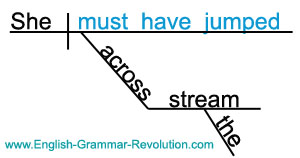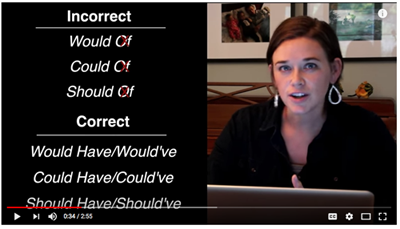A list of helping verbs will help you identify helping or auxiliary verbs in English sentences and improve your writing skills.
By learning the following helping verbs, you will quickly identify helping or auxiliary verbs in English sentences.
- am, is, are
- was, were
- be, being, been
- do, did, does
- have, has, had
- may, might, must
- can, could
- shall, should
- will, would
Helping Verbs Explained
Every sentence must have a verb and a subject in order to express a complete thought.
Sometimes, the verb of a sentence is one word. Other times the verb of a sentence is made up of a main verb and one or more helping or auxiliary verbs.
In these combinations, the last word of the group is usually called the notional verb because it gives the main idea or notion and the helping words added to it are called auxiliary or helping verbs.
These verbs which have very important auxiliary uses are have, be and do.
1. The Auxiliary Verb “HAVE”
“Have” is added to the past participle of the notional verb to form the perfect tenses.
- I have found the solution to our problem.
- The church service will have finished by the time we arrived from the airport.
2. The Auxiliary Verb “BE”
“Be” has two common auxiliary uses.
First, be is added to the present participle of the notional verb to make the progressive form.
- David is playing the piano.
- The cricket team has been worrying about the weather.
Second, be combines with the past participle of the notional verb in order to form the passive voice.
- I was told about the accident.
- The lock has been damaged by the thieves.
3. The Auxiliary Verb “DO”
“Do” combines with the simple infinitive of the notional verb to make the emphatic form in present and past tense.
- I do not like the music.
- Yes I did lock the house.
Though we use these forms to add weight and emphasis to a statement, the most common usage is asking and answering questions.
- Do you like swimming?
- Did you hear the terrible music?
These helping or auxiliary verbs can be used as notional verbs. “Have” when it means “possess,” “be” to show existence and used as a linking verb and “do” when it means accomplished.
- I have the plans for the new building. (possession)
- There is a mouse in the cupboard. (Existence)
- The photograph is perfect. (Linking)
- The athlete did the run in the allotted time. (Accomplished)
4. The Auxiliary Verbs “SHALL” and “WILL”
Shall and will are used with the simple infinitive of the notional verb in order to give us one form of the future tense.
- I shall disappear tomorrow.
- I will return next week.
5. The Auxiliary Verbs “MAY, MIGHT, MUST, CAN, COULD, WOULD and SHOULD”
These helping or auxiliary verbs are called modal auxiliaries because they indicate the mood of the speaker and his attitude toward the statement that is being made.
These auxiliaries combine with the infinitive and with the present perfect form.
- I must disappear tomorrow.
- You may have hurt him.
- The thief should be imprisoned soon.
- You might have been hurt.
Knowing the list of helping verbs (see above) will assist you in quickly identifying verb phrases in sentences.
Resources For A List of Helping Verbs
English Grammar in Use by Raymond Murphy
Plain English Handbook by J. Martyn Walsh and Anna Kathleen Walsh
The Only Grammar Book by Susan Thurman
Mastering English Grammar by S.H. Burton
You may have heard of helping verbs, which are also referred to as modal and auxiliary verbs. In this discussion, we’ll review what a helping verb is and how it works with another verb.
What Is a Helping Verb?
A helping verb is a verb that combines with a main verb to form a verb phrase. Sometimes it is also called a verb marker, because it indicates that a verb is to follow.
In a sentence with one main verb in the simple present tense, it’s typically easy to identify the verb by looking for the action word. For example:
Jim walks quickly.
Walks is the action being performed by Jim, so that’s the main verb. But what if we want to express a different time (tense) of Jim’s activity? We need another verb to provide that information. In our example with Jim, let’s tell the reader more about his action by placing it in the present progressive tense to convey that he’s doing it right now:
Jim is walking quickly.
You see we now have two verbs. The main verb is walking. The word is has been added to “help” further describe the main verb. In this case, the helping verb (is) tells of the tense of the action (present progressive). Together, the helping verb and the main verb add clarity and context. If we say only Jim walks, that action can apply to any place and any time. By saying Jim is walking, we know his action is happening in this moment.
With that in mind, let’s change our helping verb for what we want the main verb to communicate. We’ll use a Type 1 conditional sentence with a possible condition and a probable result:
If he sees an ice cream truck at the end of the street, Jim will walk quickly.
The main verb is still walk, but our helping verb is now will to let the reader know the time of the action is in the future.
Three Common Helping Verbs
Once you understand the principle of helping verbs, finding and using them gets much easier. You can also begin to recognize many of their common forms, which can change depending on whether they are indicating a past, present, or future action. They can be singular or plural as well.
Here are some helping-verb varieties you probably use every day:
To be: is, am, are, was, were, will be
To have: have, has, had, will have
To do: do, does, did, will do
Examples
We were shopping at the mall yesterday.Joan had been unaware of that until you informed her.
Chris will do what is required to make the delivery on time.
Let’s look at a few more examples:
The dog was eating the food in the bowl.
Janine has visited her mother.
If you’re wondering, Robert did rehearse for several weeks before opening night.
Other helping verbs you might see paired with main verbs include would, should, could, shall, may, might, and can.
Pop Quiz
Identify the helping verbs in the following sentences.
- Christy will be dancing at the wedding.
- Did you bake that cake on the counter?
- You have slept longer than usual today.
- I am flying to Cleveland next month.
- Bruce was seen by a specialist at the clinic.
Pop Quiz Answers
- Christy will be dancing at the wedding.
- Did you bake that cake on the counter?
- You have slept longer than usual today.
- I am flying to Cleveland next month.
- Bruce was seen by a specialist at the clinic.
Master Your Grammar One Tip at a Time
No one becomes an expert overnight. Getting good at grammar is a journey through the rules and techniques that make communication accurate, clear, and eloquent. Visit us again soon for more articles. You can also ask a question or suggest a grammar topic in the comments below!
Advertisement
If the article or the existing discussions do not address a thought or question you have on the subject, please use the «Comment» box at the bottom of this page.
Helping verbs (auxiliary verbs) do just what their name implies. They help the main verb in the sentence by telling more about the verb’s tense, mood, and voice.
Main Verbs, Helping Verbs, & Verb Phrases
There are many, many verbs that can function as main verbs (walk, run, think, say, sleep, seem etc.), but there are only a handful of verbs that can function as helping verbs.
List of Helping Verbs
be, am, is, are, was,
were, been, being, have, has, had,
could, should, would, may, might,
must, shall, can, will, do, did, does, having
When we put one or more helping/auxiliary verb with a main verb, we get what is called a verb phrase.
(Every sentence needs to have at least one main verb, but not every sentence needs a helping/auxiliary verb.)
|
Helping Verb(s) |
+ Main Verb |
= Verb Phrase |
|
could |
eat |
could eat |
|
could have |
eaten |
could have eaten |
|
might have been |
listening |
might have been listening |
Before we move on, I need to tell you something important. Are you ready? Good! The verbs on that list above can function as helping verbs. That wording is very important because some of those words can also function as main verbs. Let’s look at an example using the word was.
|
I was sleeping during the football game. |
Was sleeping is a verb phrase. Was is a helping verb, and sleeping is a main verb. |
|
I was captain of the football team. |
This sentence does not have a verb phrase. Here, was is the main verb. It’s a linking verb. |
Sometimes, the helping and main verbs are separated by other words. This often happens when we ask questions. With questions, the auxiliary verb tends to come at the beginning of the sentence, and the main verb comes later.
Words like never, not, and the contraction n’t are not part of the verb. They are adverbs.
|
Sentence |
Verb Phrase |
|
Have you been sitting in my chair? |
Have been sitting |
|
Do you know Goldilocks? |
Do know |
|
No, I don’t know her. |
do know |
Psst! Have you ever heard of modal verbs? Modals are a type of helping verb that show the speaker’s attitude about what they are communicating.
Verb Phrases Act as Verbs
This seems obvious, right? They are made up of verbs, so what else would they be acting as?
The point here is that they are made up of multiple words and all of the words come together to act as one part of speech, a verb.
The cheesecake might be exploding.
Might be exploding is telling us what the cheesecake is doing. It’s acting as a single unit: a verb.
Did you call Owen?
Did call is asking what you did. It’s acting as a single unit: a verb.
Owen has become a great cook.
Has become is telling us Owen’s state of being. It’s acting as a single unit: a verb.
Sentence diagrams can help us see that verb phrases function as verbs. Sentence diagrams are pictures of sentences that show us how parts of a sentence are related. They make the relationships between words, phrases, and clauses visual.
Verb phrases are diagrammed in the verb slot of the sentence diagram. They go on a horizontal line right after the subject. All of the words in the verb phrase go in the same slot because all of the words are coming together to function as the verb!
Remember that verb phrases are made up of at least one helping verb and a main verb.
Let’s look at an example sentence diagram with an actual sentence.
She must have jumped across the stream.
Must and have are helping verbs, and jumped is a main verb. These three verbs together form a verb phrase.
Don’t Get Tricked
The word of never acts as a helping verb, so would of, could of, and should of are incorrect. They are not verb phrases.
The correct versions are would have, could have and should have or would’ve, could’ve, and should’ve.
You can learn more about this mistake here.
There you have it! Now you’re a pro at identifying and understanding helping verbs!
If you’d like to karate chop your way through grammar, you need to check out our Get Smart Grammar Program!
It’ll save you time and heartache, and it will bring you well-earned confidence.







